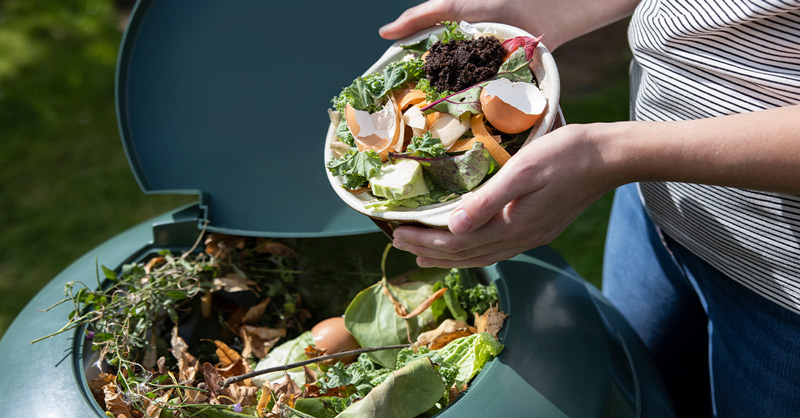Composting is a great way to reduce household waste while creating nutrient-rich soil for your garden. Managing a backyard compost bin can also be a fulfilling way to help the environment and connect with nature. Here’s how to make it efficient, effective, and rewarding.
1. Choose the right location
The first step is to choose the right location. Here are a few tips:
Pick a flat area with good drainage – Make sure the location you choose is relatively flat and not prone to standing water. A spot with good drainage ensures excess moisture can escape and prevents the compost from becoming too wet.
Avoid placing it too close to your home or your neighbours’ property – Composting can sometimes generate odours or attract pests, so you’ll want to keep it away from your home and your neighbours’ property. It’s best to place your bin at least 10 feet away from your home.
Place near your garden but away from trees – Compost can be heavy, so ideally you want your bin close to your garden or wherever you plan to use it the most. Keep the bin away from trees though, as the roots can grow into the compost pile.
Choose a spot that’s not too sunny or too shady -Choose a partially shady spot that gets a modest amount of sun exposure to help keep your compost warm. Avoid placing your bin where it can get too hot and dry out your compost.
Place close to a water source – For the decomposition process to work effectively, your compost needs to stay moist. Choose a spot that’s close to a water source or within reach of your hose. This will make it easy for you to water your compost.
2. Select the right compost bin
The two most popular types of outdoor compost bins are stationary bins, sometimes called continuous composters, and tumbler bins, often referred to as batch composters.
Stationary bins (continuous composters)
These are typically made of wood or plastic and are designed to stay in one place. Stationary compost bins can be open to the elements or covered with a lid to keep pests out. They are ideal if you generate a lot of organic waste and have a large backyard. Stationary compost bins tend to be low maintenance but may take longer to produce compost.
Tumbler bins (batch composters)
These are designed to be rotated, which helps aerate the compost and speed up the decomposition process. They are ideal if you have a small yard and don’t generate much organic waste. Tumbler bins produce compost faster than stationary bins but need to be turned regularly to keep the compost well-aerated.
3. Add the right materials
To start your compost bin, you’ll need a mixture of “green” and “brown” materials. “Green” refers to moist, nitrogen-rich materials that provide the necessary nutrients for microorganisms to break down waste. “Brown” refers to dry, carbon-rich materials that help with the aeration and structure of your compost. You’ll need roughly equal amounts of green and brown materials for a balanced compost pile.
10 greens you can add to your compost pile include:
- Fruit and vegetable scraps
- Coffee grounds and filters
- Tea bags and leaves
- Eggshells
- Houseplant trimmings
- Grass clippings and sod
- Fresh leaves
- Plain cooked rice
- Stale bread
- Corn cobs
10 browns you can add to your compost pile include:
- Shredded newspaper
- Plain, corrugated cardboard
- Hay and straw
- Wood chips and sawdust
- Leaves and twigs
- Used napkins and paper towels
- Paper egg cartons
- Brown paper bags
- Nutshells
- Animal bedding
4. Avoid certain materials
While most organic materials can be composted, there are a few things you should avoid as they can attract pests or slow down the composting process. Here are some examples:
- Meat, fish, bones, and dairy products
- Grease, oil, and fats
- Weeds with seeds
- Coal and charcoal ash
- Pet waste
- Plastics and synthetic fabrics
- Glass and metal
- Glossy paper
5. Keep the compost moist
Composting requires moisture to keep the microorganisms that break down organic matter alive. Aim for a moisture level that feels about as moist as a wrung-out sponge. If the compost feels too dry, add water, and if it feels too wet, add more brown materials. Wet your compost pile as you add new material and try to keep your compost damp but not soggy.
6. Monitor the temperature
Your compost pile will heat up as the materials in your bin decompose. Maintaining the proper temperature is an important aspect of successful composting. If the temperature gets too low, the decomposition process will slow down, while the compost can dry out if the temperature is too high. You can use a specialized compost thermometer with a long probe to measure the temperature.
7. Turn the compost regularly
To speed up the composting process, you’ll need to turn your pile regularly. This will help provide oxygen to the microorganisms that are breaking down the waste. Depending on the type of compost bin you have, you may need to turn it with a shovel or simply rotate the tumbler. As a rule of thumb, compost should be turned every 3 to 4 days.
Once your compost has turned into a dark, soil-like substance, it’s ready to use! Spread it around your garden to improve soil quality or mix it into potting soil to give household plants a healthy boost.
Just like any well-designed system, composting thrives on consistency. Composting is not only great for the environment, but also for reducing the amount of waste you send to landfills. Start composting today and enjoy a greener lifestyle!
Need to update your home insurance policy? Now is the perfect time with The Personal.
To find out more, call 1-888-476-8737.
Or visit thepersonal.com/ospe





Leave a Comment